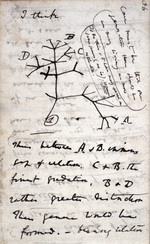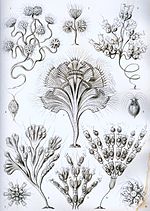The evolution of flagella is of great interest to biologists because the three known varieties of flagella – (eukaryotic, bacterial, and archaeal) each... 13 KB (1,638 words) - 21:37, 13 October 2023 |
 | range of microorganisms to provide motility. Many protists with flagella are known as flagellates. A microorganism may have from one to many flagella. A... 62 KB (6,932 words) - 21:07, 15 March 2024 |
developments and advances in biology such as an improved understanding of the evolution of flagella, have already undermined these arguments The idea that seemingly... 169 KB (17,360 words) - 17:02, 4 April 2024 |
 | Symbiogenesis (redirect from Symbiotic theory of cellular evolution) ultrastructural similarities to bacteria or to archaea (see also: Evolution of flagella and Prokaryotic cytoskeleton). According to Margulis and Dorion... 68 KB (7,283 words) - 12:56, 17 April 2024 |
 | Evolution is the change in the heritable characteristics of biological populations over successive generations. It occurs when evolutionary processes... 238 KB (24,700 words) - 04:40, 1 April 2024 |
 | The evolution of cetaceans is thought to have begun in the Indian subcontinent from even-toed ungulates (Artiodactyla) 50 million years ago (mya) and to... 81 KB (9,674 words) - 21:47, 13 March 2024 |
contain their own DNA[citation needed] (notably the flagellum – see evolution of flagella). Eukaryotic cells are structurally complex, and by definition are... 28 KB (2,348 words) - 03:23, 19 February 2024 |
 | Eukaryote (redirect from Evolution of eukaryotes) They are composed mainly of tubulin, and are entirely distinct from prokaryotic flagella. They are supported by a bundle of microtubules arising from... 61 KB (6,029 words) - 17:45, 15 April 2024 |
 | Rotating locomotion in living systems (category Speculative evolution) the exception of certain flagella, which work like corkscrews). Biologists have offered several explanations for the apparent absence of biological wheels... 61 KB (5,825 words) - 15:21, 13 March 2024 |
 | Protist locomotion (redirect from Protist flagella) protozoans, are motile and can generate movement using flagella, cilia or pseudopods. Cells which use flagella for movement are usually referred to as flagellates... 93 KB (9,335 words) - 19:28, 9 April 2024 |
 | Sperm (redirect from Evolution of sperm) type of cilium (aka flagella). In many animals the sperm tail is formed through the unique process of cytosolic ciliogenesis, in which all or part of the... 30 KB (3,388 words) - 11:29, 3 April 2024 |
 | Opossum (redirect from Evolution of opossums) sperm-pairing, forming conjugate pairs in the epididymis. This may ensure that flagella movement can be accurately coordinated for maximal motility. Conjugate... 67 KB (6,114 words) - 17:47, 18 April 2024 |
 | Stramenopile (section Evolution) are a clade of organisms distinguished by the presence of stiff tripartite external hairs. In most species, the hairs are attached to flagella, in some they... 33 KB (3,303 words) - 08:16, 17 April 2024 |
 | appendages called flagella. The word flagellate also describes a particular construction (or level of organization) characteristic of many prokaryotes... 12 KB (1,240 words) - 11:46, 17 April 2024 |
 | The evolution of mammalian auditory ossicles was an evolutionary process that resulted in the formation of the bones of the mammalian middle ear. These... 39 KB (4,175 words) - 17:13, 10 March 2024 |
 | Bryophytes have 2 flagella, horsetails have up to 200 and the mature spermatozoa of the cycad Zamia pumila has up to 50,000 flagella. Cycads and Ginkgo... 13 KB (1,499 words) - 20:22, 8 April 2024 |
 | Cell (biology) (redirect from Parts of a cell) cilia or flagella. Motile cells are absent in conifers and flowering plants.[citation needed] Eukaryotic flagella are more complex than those of prokaryotes... 62 KB (6,360 words) - 07:29, 17 April 2024 |
Nick Matzke (category University of California, Berkeley alumni) lengthy paper about the evolution of flagella and has continued to challenge claims from intelligent design proponents that flagella are irreducibly complex... 14 KB (1,189 words) - 05:57, 1 April 2024 |
 | Bacterial motility (section Modes of locomotion) sliding, which are all independent of flagella. Twitching depends on the extension, attachment to a surface, and retraction of type IV pili which pull the cell... 109 KB (12,262 words) - 04:56, 1 January 2024 |
 | Kinetoplastida (section Flagella) with two flagella most forms have a leading and trailing flagellum, the latter of which may be attached to the side of the cell. The flagella are used... 13 KB (1,306 words) - 23:56, 24 February 2024 |
Irreducible complexity (category Creationist objections to evolution) the evolution of the flagellum, including horizontal gene transfer. Evolution from type three secretion systems. The basal body of the flagella has been... 125 KB (14,635 words) - 17:53, 23 February 2024 |
Experimental evolution is the use of laboratory experiments or controlled field manipulations to explore evolutionary dynamics. Evolution may be observed... 45 KB (5,087 words) - 04:23, 15 April 2024 |
 | Transitional fossil (redirect from List of transitional fossils) fact that one of the goals of evolutionary taxonomy is to identify taxa that were ancestors of other taxa. However, because evolution is a branching... 53 KB (5,685 words) - 20:41, 26 March 2024 |
 | The evolution of bacteria has progressed over billions of years since the Precambrian time with their first major divergence from the archaeal/eukaryotic... 18 KB (1,664 words) - 17:55, 22 March 2024 |





